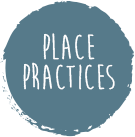

1. Pipe Cleaner and Ribbon
This clips shows some of the results of an activity which explores shifting, and finding new, perspectives on everyday places. The participants are given pieces of ribbon and a pipe cleaner and asked to place them somewhere in relation to one of the places they pass or inhabit on a daily basis. The objective is to somehow shift the perspective of that place through the addition of ribbon or pipe cleaner, disrupting everyday places. This on site activity is shared by participants through photos posted on facebook, allowing a range of responses to be imparted to the whole group and for these responses to be commented on by others.
3. The Lost Boy: Film making to explore place
This clip shows a film made with participants which explores the site of the Half Moon building. Working in an area of the building which is not ordinarily used – the basement – the participants work from this area to devise a short narrative which explores that particular place. The result – a mystery story about a lost boy – allows the participants involved to interact with and use this familiar/unfamiliar place as a catalyst for performance, which is captured on camera and subsequently edited together by the facilitator.
2. Scattering Cornflakes
This clip shows part of an exercise run by the facilitators of the Half Moon project to disrupt the familiar, unremarkable journey of the participants to the theatre. Chosen for their commonplace quality, the facilitators scatter cornflakes, along the pavement towards Half Moon and into the building itself. The participants then arrive, crunching over the cornflake path, renewing their routine experience of arriving at the weekly session. This activity is followed by discussion of the effect of the exercise on their perception of place and by further activities exploring the everyday through cornflakes, which becomes a motif of the work carried out (see In the Studio / Disrupting everyday actions: Cornflakes).
4. Filming at Home: Playing with Place
In this clip, the filmed results of an activity used to explore the everyday places of some participants can be seen. A facilitator with a camera goes to each of these participants’ homes and surrounding areas and together they explore how some of their everyday actions, such as playing Xbox, eating breakfast, tying a tie and changing a TV channel can be playfully disrupted. With this prompt, the participants experiment with shifting the context for everyday actions, so that they become unfamiliar. This activity proves to be a strong method for disrupting the everyday, through drawing on, and working within, the everyday sites of the participants, rather than bringing these sites into the studio. Given time, more of this kind of work would have been useful.

